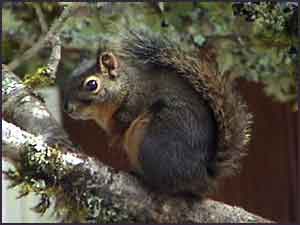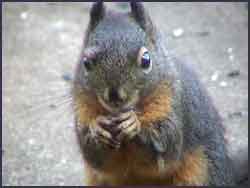Douglas Squirrel or Chickaree
Douglas Squirrel Video Clips

The Douglas Squirrel and Townsend's Chipmunk were first noted by Lewis and Clark on February 25, 1806, at Fort Clatsop, Oregon. In our backyard, the Douglas Squirrel didn't arrived until the summer of 2003.
Douglas Squirrel Identification
We have only one native tree squirrel in Waldport, Oregon. It is the Douglas Squirrel (Tamiasciurius douglasi) also known as a Chickaree. According to The Peterson Field Guide Series, A Field Guide to the Mammals, by Burt & Grossenheider, only the Douglas Squirrel is called a Chickaree. Note however that the Red Squirrel (Tamiasciurus hudsonicus), who doesn't live in the Pacific Northwest, is also referred to as a chickaree.
The Douglas Squirrels are feisty critters. They are about 6 to 7 inches. Their wrap their tails, which are about 5 inches in length, over their backs. Like all rodents or "gnawing mammals," they have orange or yellow colored front teeth that are constantly growing and have to be worn down by chewing. The ears of tree squirrels are located on the sides of their head like humans. Other rodents, like rats and mice, have ears facing forward.
Douglas Squirrel Sound Clip
To listen to a sound file and view a waveform and spectrogram image click here.
Douglas squirrels are noisy and have a large repertoire of calls, including a trill. They guard their forested areas and let everyone know when when predators or humans enter their forested kingdom by making a very loud warning call. They also talk with their tails and make chattering sounds while they eat telling others to keep their distance or watch out. They are extremely territorial with each other and the smaller chipmunks.
Food Habits & Sources

These squirrels gathers seeds from conifers such as Douglas Fir, Sitka Spruce, Hemlock and others. They chew off a number of cones letting them fall to the ground. Once a small pile builds on the ground, they start the process of gathering and storing. There are a couple of areas around our property where they sit peeling off the scales to get to the seeds. When a large number of discarded scales builds up on the ground, it is referred to as a "midden."
Squirrels have quite a variety of food sources besides their conifer diet including bird eggs and baby chicks, baby mice, invertebrates, mushrooms, flowers, and nuts. We've watched them collect flowering quince fruits and stash them under tarps.
Courtship
Naturepark describes a courtship that "includes chases around the base of trees that may be fast, frantic and noisy. Watch for this behavior about late March. Four kits are usually born in April. These mature quickly and within about 3 months are on their own. Sometimes they will have a second litter because of the longer season. A lone Douglas Squirrel occupies a territory of about 1 hectare (2 to 3 acres) and will defend their territory using calls and chasing other squirrels out of their territory. The tables are turned when the offending squirrel goes back into his own territory and he will chase the follower back into its own area. The only time they will share territories is during mating season and when females raise their young."
Protect Bird Houses from Squirrels
Squirrels are extremely agile and aggressive. They aggressively chase other squirrels, chipmunks, crows, band-tailed pigeons and birds away from their eating space.
Their agility allows them to jump great distances. Previously protected bird houses with a predator guards no longer worked because they could jump from the trees to the houses. In 2005, a Douglas Squirrel jumped from an alder tree to a Chestnut-backed Chickadee house and started chewing through the entrance hole. Fortunately, the chickadees had fledged. Unfortunately, the chickadee had nested in that house at that location for 6 years and we had to move the house out of the alder grove.
Squirrel Kills Norway Rat
On June 4, 2005, a jay was loudly squawking, sounding like it was being attacked. I ran to the window and saw a young Steller's Jay bouncing up and down flapping its wings while it screamed and squawked looking at something fighting only two feet in front of it. I didn't see any blue feathers, so it wasn't another jay in the fight. I ran out the door very concerned a squirrel was attacking a chipmunk. As soon as I opened the door, a squirrel took off and there was a critter lying on the ground. I was shocked to see a very large Norway rat barely breathing. The squirrel had bitten it many times along the back and the rat couldn't move. Only minutes later, a crow came down and flew off with the dead rat.
Muir's Musings on the Douglas Squirrel
In Chapter 9 of The Mountains of California by John Muir (1894), he wrote: "No one who makes the acquaintance of our forester will fail to admire him; but he is far too self-reliant and warlike ever to be taken for a darling." Muir's article contains many interesting facts and observations about the Douglas Squirrel. For example, "Nature has made him master forester and committed most of her coniferous crops to his paws. Probably over fifty percent of all the cones ripened on the Sierra are cut off and handled by the Douglas alone, and of those of the Big Trees perhaps ninety percent pass through his hands."
Squirrels Mutualism
Douglas Squirrel Mutualism is a relationship where two entities benefit from each other. In this case, it is between the Douglas squirrel and conifer trees. Conifer trees provide food and shelter for the squirrel. The squirrel provides seed dispersal to more distant areas; provides protection by eating harmful tree grubs; and helps pollination by eating pollen cones and spreading pollen via their fur.
Squirrel Stories
If you have an interest in squirrels, there is an outrageously funny and entertaining book, Nuts About Squirrels by Richard L. Mallery. For example, Mr. Mallery writes, "When a squirrel senses danger, his first instinct is to stand motionless. His second instinct is to swallow hard and chew faster."
TwoBookMark posted Chapter 1 of Nuts About Squirrels by Richard L. Mallery for review. I found the following story about a Douglas Squirrel very entertaining. The author writes,
A bit smaller than gray or fox squirrels, Douglas squirrels range through the Sierras from Mexico to British Columbia-but one, dubbed Walla Walla, tried to extend his range to Alaska. Walla Walla apparently "squirreled away" in a U.S. Postal Service shipping container that left Seattle. The little guy went first-class to Fairbanks, where he came down the sort line with insufficient postage. Mail sorters in Fairbanks thought the squirrel had just wandered into the building.
A postal facility is not a squirrel-friendly place. Besides all the conveyor belts and sorting machinery, a lot of postal workers carry guns. At first, the postal employees tried to shoo the squirrel out a door. But Walla Walla was no dummy. It was 15 degrees below zero, with about nine inches of snow on the ground. He refused to go outside.
Walla Walla was able to find plenty of food by shopping through packages in the various shipping containers stored around the facility. When Alaska Fish and Game personnel were finally called in to capture the squirrel, he was trapped in a container headed for Prudhoe Bay. That would have been a big mistake. He was a little snappy, but I guess that's what happens when you hang around a postal facility for a couple days.
Once captured, Walla Walla did not resemble the reddish brown squirrels of Fairbanks. Fish and Game checked his pelt with specimens at the University of Alaska Museum and confirmed that Walla Walla was a Douglas squirrel. Since this species is protected in Washington State, Fish and Game felt obligated by law to return the squirrel. First they named him after Walla Walla, Washington, a city in his home range. He dined on yams, fruit, and peanuts while officials booked him onto an Alaskan Airlines flight back to Seattle. He was given ambassador treatment. When his plane touched down in Seattle, he was met by Fish and Game employees there, who then escorted him to Governor Mike Lowry's mansion at the state capital in Olympia, Washington.
Walla Walla became something of a star. He was never invited to dinner, but then when did a squirrel ever need an invitation? The governor's mansion is an officially designated Backyard Wildlife Sanctuary, and Walla Walla was used to draw attention to the BWS program, which allows homeowners to obtain the sanctuary designation if they agree to certain conditions to help maintain birds, animals, and plants native to the state. No matter how nice you are to your squirrels, however, you still cannot claim them as dependents on your state income tax.
Squirrel - The Gatherer
The keyword for squirrel is "gathering." According to Medicine Cards by Jamie Sams & David Carson, the squirrel teaches us to plan ahead, to store our energy for times of need, and to prepare for the future.
